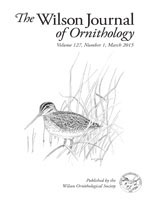Longevity records inform demographic studies and our understanding of avian senescence evolution, yet studies on free-ranging species are rare, especially in the tropics. Here we provide minimum longevity records for the Marsh Antwren Formicivora acutirostris (Thamnophilidae), a small (9.8 g) territorial bird inhabiting tidal marshes in southern Brazil. We recorded a 16.2-year-old male and a 14.2-year-old female, both breeding before they were last seen, as well as 31 individuals between 6–10.2 years of age. There was no difference in the sex-ratio between these individuals. The oldest male was nearly 2 years older than the oldest thamnophilid recorded to date, and twice as old as the oldest recorded breeding individual. We also observed behaviors which we interpret as signs of aging, such as the isolation of the old female and her apparent indifference to her mate, and frequent territory disputes involving the old male and floater males.
How to translate text using browser tools
1 March 2015
Longevity Records and Signs of Aging in Marsh Antwren Formicivora acutirostris (Thamnophilidae)
Marcos R. Bornschein,
Marco Aurélio Pizo,
Daiane D. Sobotka,
Ricardo Belmonte-Lopes,
Claudia Golec,
Tiago Machado-de-Souza,
Marcio R Pie,
Bianca L. Reinert
ACCESS THE FULL ARTICLE
Atlantic forest
Brazil
longevity
maximum breeding age
senescence





